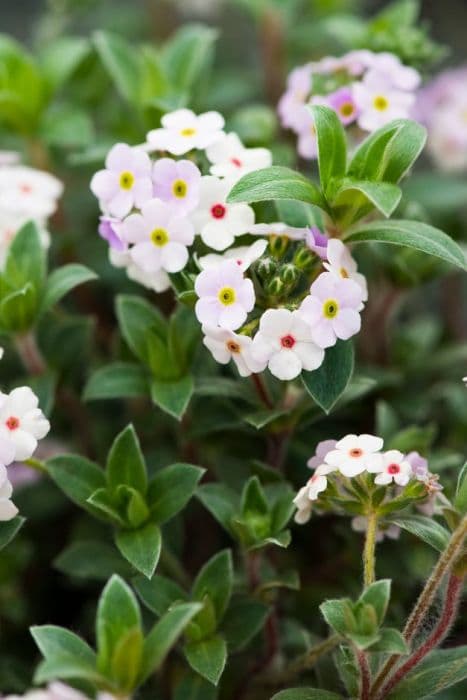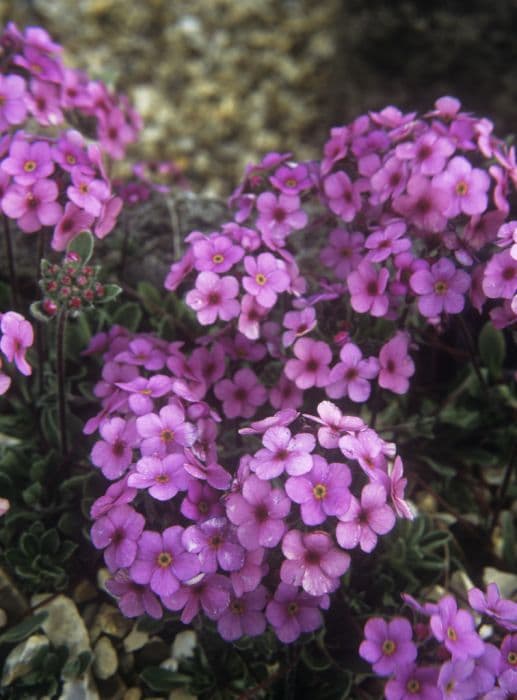Persian Violet Cyclamen 'Laser Scarlet'

ABOUT
The Cyclamen 'Laser Scarlet' is a striking plant known for its vibrant scarlet flowers that stand out with a deep, rich tone. Each flower is characterized by an elegant, swept-back shape, resembling a shuttlecock or a dancer's twirling skirt. The blooms are borne on slender stems that rise above the foliage, making the flowers highly visible and a focal point of the plant's appearance. The foliage of Cyclamen 'Laser Scarlet' is equally attractive, featuring heart-shaped leaves that are often marbled with silver and green patterns. The leaves form a compact mound, from which the flower stems emerge. This creates a lush backdrop for the scarlet blossoms, enhancing their visual impact. The contrast between the dark green leaves and the bright red flowers creates a dramatic display that catches the eye. Overall, the Cyclamen 'Laser Scarlet' has a graceful and elegant aesthetic, with its exquisite flowers and ornate leaves creating a visual feast. It is a popular choice for adding a splash of color to indoor spaces or shaded garden areas where its beauty can be fully appreciated.
About this plant
 Names
NamesFamily
Primulaceae
Synonyms
Persian Violet, Florist's Cyclamen, Sowbread
Common names
Cyclamen 'Laser Scarlet'.
 Toxicity
ToxicityTo humans
Cyclamen, particularly Cyclamen 'Laser Scarlet', can be toxic if ingested by humans. While it is primarily grown for its decorative qualities, all parts of the plant contain toxic substances, namely saponins. If ingested, these can cause symptoms including nausea, vomiting, and diarrhea. In severe cases, it can lead to heart rhythm abnormalities, seizures, and even death, although such extreme reactions are rare. Contact with the skin can sometimes cause an allergic reaction, but it’s the ingestion of the plant parts that poses the most risk to humans.
To pets
Cyclamen is also toxic to pets, such as cats and dogs. Ingesting any part of the plant can result in symptoms that typically include vomiting, diarrhea, and excessive salivation. More severe symptoms can develop if a significant amount of the plant is ingested, including heart rhythm disturbances, seizures, and potentially death. The roots of the Cyclamen plant contain the highest concentration of the toxic principles, and therefore pose the greatest risk if pets dig up and chew on them. It is important to keep this plant out of reach of pets to prevent accidental ingestion.
 Characteristics
CharacteristicsLife cycle
Perennials
Foliage type
Evergreen
Color of leaves
Variegated
Flower color
Scarlet
Height
6 inches (15 cm)
Spread
6 inches (15 cm)
Plant type
Bulb
Hardiness zones
9
Native area
Mediterranean
Benefits
 General Benefits
General Benefits- Vivid Color: Cyclamen 'Laser Scarlet' provides vibrant scarlet flowers that can brighten up indoor spaces or shaded garden areas.
- Decorative Foliage: The plant features attractive, heart-shaped leaves that often have a silver or pale green pattern, adding to its decorative appeal.
- Compact Growth: It has a compact growth habit which makes it suitable for container gardening, small gardens, or as a houseplant.
- Seasonal Interest: Cyclamen 'Laser Scarlet' typically blooms in the fall and winter, providing color and interest during the colder months when few other plants are flowering.
- Easy Care: It is relatively easy to care for when provided with the right conditions, making it suitable for novice gardeners.
- Long Blooming: The plant can have a long blooming period, lasting several weeks to even months with proper care.
- Drought Tolerant: Once established, Cyclamen 'Laser Scarlet' is fairly drought-tolerant, requiring less frequent watering compared to many other flowering plants.
 Medical Properties
Medical PropertiesThis plant is not used for medical purposes.
 Air-purifying Qualities
Air-purifying QualitiesThis plant is not specifically known for air purifying qualities.
 Other Uses
Other Uses- Artistic Inspiration: Cyclamen's vibrant scarlet flowers and unique shape can serve as a muse for artists, who may depict the plant in paintings, drawings, or photography to capture its beauty.
- Photography Subjects: Due to their striking appearance, Cyclamen are often used in macro photography to explore the intricate patterns and colors of their petals and leaves.
- Educational Tool: Biology teachers and educators can use the Cyclamen to demonstrate plant anatomy, such as corm development, flower structure, and leaf variegation.
- Seasonal Decor: Cyclamen are popular choices for adding a pop of color to autumn and winter decor in homes and commercial spaces, thanks to their seasonal blooming period.
- Culinary Garnish: Although not commonly used and not advisable for consumption, Cyclamen petals can be used as an ornamental garnish for dishes in high-end restaurants, after ensuring they are safe for this purpose.
- Gifting Plants: With its bright flowers and heart-shaped leaves, Cyclamen can be gifted as a symbol of deep love and affection during special occasions.
- Garden Design: Cyclamen can play a role in garden design, creating colorful borders or being featured in rock gardens due to their ability to thrive in well-drained soils.
- Craft Projects: Dried Cyclamen flowers can be used in crafting, for example, in potpourris, pressed flower art, or homemade greeting cards.
- Symbolic Planting: Cyclamen can be planted in memory gardens as their blooming can coincide with significant dates or seasons, serving as a living tribute to loved ones.
- Living Favors: Miniature Cyclamen plants can be given as living party favors during events or weddings, offering guests a lasting reminder of the occasion.
Interesting Facts
 Feng Shui
Feng ShuiCyclamen is not used in Feng Shui practice.
 Zodiac Sign Compitability
Zodiac Sign CompitabilityCyclamen is not used in astrology practice.
 Plant Symbolism
Plant Symbolism- Deep Love: Cyclamen, with its heart-shaped leaves and lasting flowers, often symbolizes deep and sincere love.
- Goodbye: In the language of flowers, giving cyclamen can imply a parting or a separation, suggesting a farewell or an expression of a desire to take a break in a relationship.
- Sincerity: The enduring quality and the graceful appearance of the flowers often convey sincere feelings and emotions.
- Shyness: Due to its characteristic of drooping its head downward, cyclamen can represent diffidence or shyness.
 Water
WaterCyclamen, commonly known as Persian Violet, requires careful watering to thrive. It's best to water them beneath the leaves, directly onto the soil to avoid rotting the stems and leaves. Keep the soil lightly moist during the growing season by watering it with approximately 8 ounces of water every week, depending on the environmental conditions. Reduce watering once the leaves start to yellow and the plant enters dormancy. Overwatering can be detrimental, so allow the soil to dry out slightly between waterings.
 Light
LightCyclamen, also known as Persian Violet, prefers bright, indirect light and should be placed near a north or east-facing window. Direct sunlight can scorch the leaves, so it's important to provide diffused light, especially in the warm months. A spot with dappled shade is ideal for maintaining the vibrancy of its flowers and leaves.
 Temperature
TemperaturePersian Violet enjoys cool conditions and thrives at temperatures between 50°F and 68°F. It's important to protect the plant from temperatures above 68°F, as higher temperatures can induce dormancy. Make sure to also keep the cyclamen away from drafts and heat sources, and maintain a minimum temperature of about 40°F to prevent cold damage.
 Pruning
PruningPruning a Persian Violet involves removing yellowing or dead leaves and spent flowers to encourage more blooms and maintain plant health. The best time to prune is immediately after the flowers fade. Pruning is typically done on an as-needed basis, whenever the plant appears untidy or when leaves and flowers start to wither. Avoid excessive pruning, as this can stress the plant.
 Cleaning
CleaningAs needed
 Soil
SoilCyclamen prefers well-drained, loose soil with a mix of potting soil, peat, and perlite or sand. For Cyclamen 'Laser Scarlet', a slightly acidic to neutral pH of 6.5-7.0 is ideal.
 Repotting
RepottingCyclamen 'Laser Scarlet' generally needs repotting every 1-2 years. The best time to repot is after the plant has finished flowering and begins to go dormant.
 Humidity & Misting
Humidity & MistingCyclamen 'Laser Scarlet' thrives in moderate to high humidity, around 50-70%. Avoid placing in overly dry environments, as this can stress the plant.
 Suitable locations
Suitable locationsIndoor
Place in bright, indirect light; keep soil moist but not soggy.
Outdoor
Plant in dappled shade; shelter from harsh conditions.
Hardiness zone
5-9 USDA.
 Life cycle
Life cycleThe life of Cyclamen 'Laser Scarlet', commonly known as Persian Cyclamen, begins as a tuber that sprouts roots, leaves, and flowers as the temperature cools. In late summer or early autumn, foliage emerges, followed by the blooming of scarlet flowers that can last until the spring. After flowering, the plant enters a dormancy phase during the hotter months, where the leaves yellow and die back as the tuber rests. During dormancy, it is crucial to reduce watering to prevent tuber rot. Once cooler temperatures return, the cyclamen will break dormancy, initiating a new cycle of growth and bloom. Properly cared for tubers may live and continue to re-sprout for many years.
 Propogation
PropogationPropogation time
Early summer
Cyclamen 'Laser Scarlet', commonly known as a variety of Persian cyclamen, is most frequently propagated through seed. The best time to sow cyclamen seeds is in summer to early fall, allowing them to germinate and grow during the cooler months when they naturally thrive. To propagate, seeds should be soaked in water for 12 to 24 hours to soften the seed coat. After soaking, they can be sown about 1/8 inch (approximately 3 mm) deep in a well-draining soil mix. The soil should be kept evenly moist but not soggy, and the seeds require darkness and a temperature of around 60-65°F (15-18°C) to germinate. Germination can be slow, sometimes taking one to three months. Seedlings need careful attention and should be transplanted to individual pots once they're large enough to handle.









